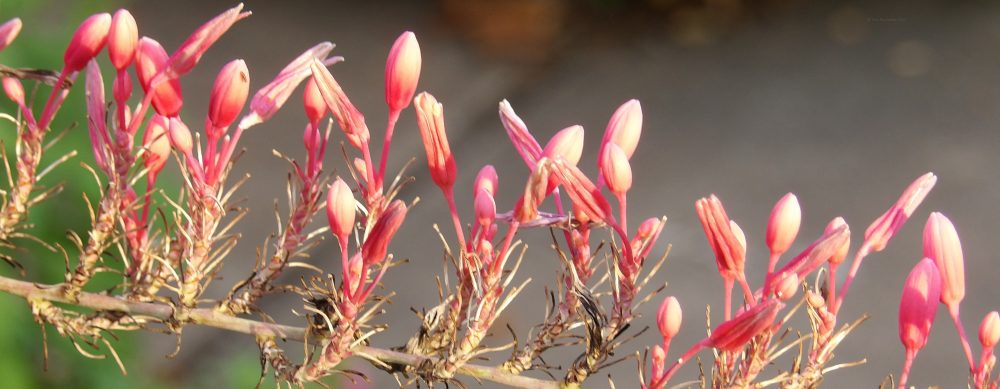From Wikipedia: Hemerocallis fulva, the orange day-lily, tawny daylily, corn lily, tiger daylily, fulvous daylily, ditch lily or Fourth of July lily, is a species of daylily native to Asia.
I usually call them orange lilies. My mother-in-law gifted to me these summer beauties a couple of decades ago, as hers were in deep shade. She wasn’t a gardener, but somehow had these growing alongside her driveway, never blooming, but always offering grassy-green foliage on warm spring and summer days. I planted the ones she gave to me–it was only 3 or 4 individuals–and grew them in a part-shade area of my front garden during these past 20 plus years. The lily plants spread, foliage usually attractive (except for deep summers and winters), and flowers always showy. I separated the lilies, giving many away, moving others to varying parts of my garden, with mixed results. Though not native in my mostly native plants garden, these June-blooming lilies have always been easy to grow, requiring little maintenance. Not a huge draw for pollinators, some native green sweat bees will visit the stamens when the flowers open.
After winter storm Uri froze Texas in 2021, and we removed the remainder of the mature, but severely freeze damaged Arizona Ash in the following autumn, I knew these lilies would struggle in the full blast of the Texas summer sun. And so they did: the next summer, the lilies produced puny, dwarfed blooms and scorched foliage. If the lilies were to survive and grow their glorious selves, they would have to be transplanted to a different, more amenable, spot in my garden.
I dug up all the lilies and planted in several spots of my part-shade back garden. Huzzah! The orange lilies have thrived! It’s not really a surprise, as these are ridiculously easy plants to grow, requiring very little–just some soil, occasional rainfall, and the appreciative oohs and aahs of their many admirers.
This little group dances in the breeze, fronting a lush, just beginning its bloom time, Turk’s Cap, Malvaviscus arboreus, shrub. The thin, arching foliage of the lilies contrasts well with the wider, heart-shaped, tropical looking Turk’s Cap leaves.

The flamboyant flowers bloom atop slender stalks that reach one to two feet in height. There are usually 10-15 flowers per stalk, blooming over a period of weeks, each flower open for only one day.

In one section of my garden which now hosts orange lilies, I’ve also planted some companion Purple Coneflower, Echinacea purpurea, and I wish I’d planted more. I like this combo of color and bloom type. In autumn, I’ll add extra of both kinds of flowers.

Here’s a nice profile view, augmented by a spider’s web. Do you see it?

Near the pond, the daylilies are keeping company with various metal and wooden birds. Mexican Feathergrass, Nassella tenuissima, is a silvery bed for the lily foliage and flowers, while Inland Sea Oats, Chasmanthium latifolium, serves as a graceful backdrop to the pops of audacious orange.

There are still weeks left in their flowering season, each day supplying fresh orange beauty, and there’s always some promise of a few blooms appearing at the end of summer, after tropical rains. The part-shade from the Red Oak trees will allow the lily foliage to remain sweet green, even in mid-to-late summer’s heat.
The orange lilies of my garden are right at home, once again.
